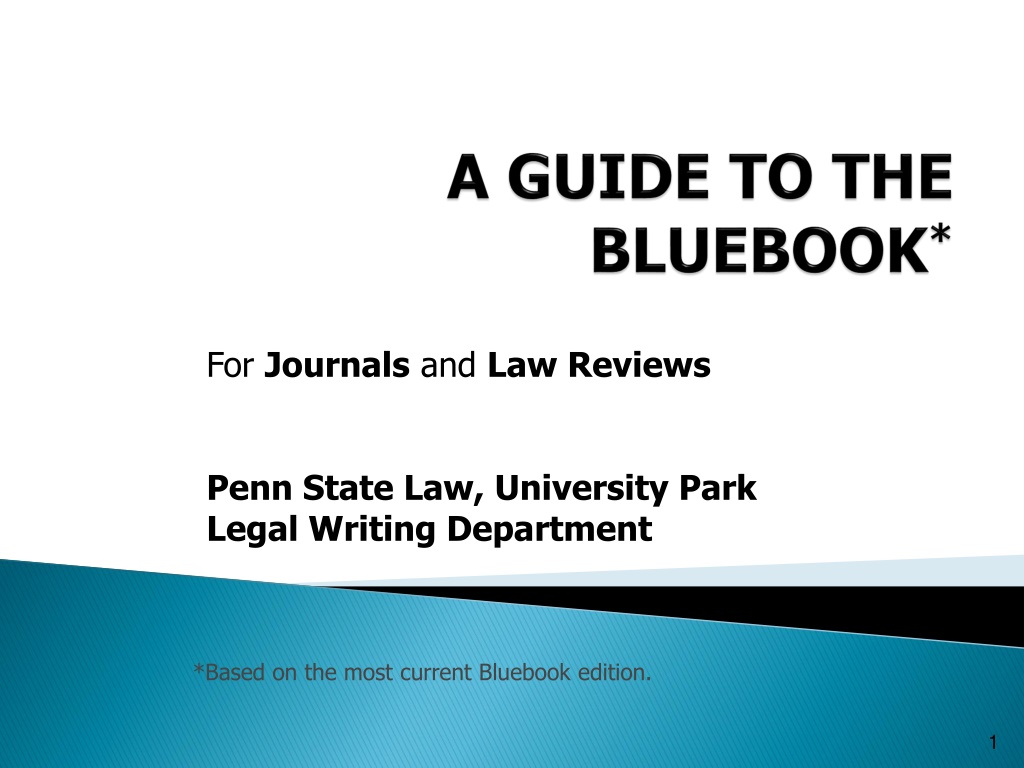Bluebook Guide for Law Reviews and Journals at Penn State Law
The presentation provides a detailed overview of the Bluebook rules and formatting conventions for citing legal sources in law reviews and journals, specifically tailored for Penn State Law students. It covers proper citation forms, typeface conventions, and examples for main text and footnote citations.
Download Presentation

Please find below an Image/Link to download the presentation.
The content on the website is provided AS IS for your information and personal use only. It may not be sold, licensed, or shared on other websites without obtaining consent from the author. Download presentation by click this link. If you encounter any issues during the download, it is possible that the publisher has removed the file from their server.
E N D
Presentation Transcript
For Journals and Law Reviews Penn State Law, University Park Legal Writing Department *Based on the most current Bluebook edition. 1
Most of the slides will first reference in italics the Bluebook table or rule that the slide covers. Turn to that page in the Bluebook and identify where the information on the slide is printed in the Bluebook. Use the index for other rules not covered in the guide. 2
Citation forms used for law reviews & journals are in the white pages. The major differences between the bluepages (for practitioners and law clerks) and white pages are formatting & font changes. See R2 Law Reviews have two types of text main text and footnote text. Your decision on which typeface convention to use depends on the type of text. For example, the typeface convention differs for case names depending on whether the case name is in the main text or the footnote text. In footnote citations, law reviews use three types of typefaces: Ordinary roman (plain text), Italics, and LARGEAND SMALL CAPS (Rule 2.1). 3
R2.1(a) & R10.2 In law review main text, case names are italicized. In footnote text, use ordinary roman/plain text for case names in a full citation or for case names in a short citation when both parties are referenced. However, in the short cite format when only one party is referenced, italicize the case name. Also, in footnote text, italicize procedural phrases in the case name. Example: Textual Sentence: In Southern Pacific Co. v. Jensen, Justice McReynolds stressed the value of uniform laws.1 Citation: 1 See, e.g., S. Pac. Co. v. Jensen, 244 U.S. 205, 225-26 (1917). 4
Practitioners Brief: Directors manage the business and affairs of a corporation. See Revlon, Inc. v. MacAndrews & Forbes Holdings, Inc., 506 A.2d 173, 179 (Del. 1986). Law Review Article: Directors manage the business and affairs of a corporation.1 1See Revlon, Inc. v. MacAndrews & MacAndrews & Forbes Holdings, Inc., 506 A.2d 173, 179 (Del. 1986). 5
R6.2(a) In general, spell out the numbers 0-99 except: Spell out ANY number that begins a sentence, Spell out hundred, thousand, or any round numbers may be spelled out, When a series includes numbers both less than 100 & greater than or equal to 100, numerals should be used for the entire series, Use numerals with decimal points, percentages, or dollar amounts, sections or other subdivision numbers. 6
R1 Citations to legal authorities are NOT placed in parentheses. The three main parts of a citation are the signal, the source of authority, and a parenthetical explanation. Some citations do not have a signal or a parenthetical explanation, but they all have the source of authority. Example of a citation with all three parts: 23 See 5 U.S.C. 553(b) (requiring agencies to publish notice of proposed rulemaking). 7
R1.1 Citation sentences are used to cite authorities that relate to the entire preceding sentence. Citation sentences begin with a capital letter and end with a period. A string citation contains numerous citations, each separated by a semi-colon. Example: Parker v. Marpoe, 789 So. 2d 86, 91 (Al. 2000); Smith v. Fulton, 390 A.2d 72, 78 (Pa. 1999). 3 United States v. Dodd, 538 F.2d 980, 984 (7th Cir. 1996); 8
R1.1 Citation clauses are used to cite authorities that relate to only part of a sentence within a footnote. Citation clauses do not start with a capital letter, unless the clause begins with a source that would otherwise be capitalized. Use commas to separate citation clauses from text unless the citation clause ends the entire sentence (in that case, place a period at the end of the citation clause). Example: 31 A party asserting the attorney-client privilege must provide an explanation of why the items are privileged, United States v. Zolin, 491 U.S. 554 (1989), and must prove the elements necessary to establish the privilege, Hawkins v. Stables, 148 F.3d 379, 383 (4th Cir. 1998). 9
R3.2 When citing material that spans more than one page, provide the inclusive page numbers, separated by a hyphen. Always retain the last two digits, but drop other repetitious digits. Example: 42 Gibbons, 455 F.2d at 356-57. Cite nonconsecutive pages by giving the individual page numbers separated by commas. Cite a footnote by using n. and cite multiple footnotes by using nn. Example: 8 Id. at 359 n.8 (Note there is no space between the n. and the note number). 10
How do we take information from an opinion: William H. Smith, Plaintiff-Appellee, vs. Emma K. Jones & Peter Griffith, Defendants- Appellants. Page 385 of Volume 983 of the South Western Reporter, Second Series Decided by the Texas Supreme Court on January 20, 1998 And transform it into a proper Bluebook citation? 10 Smith v. Jones, 983 S.W.2d 385 (Tex. 1998). 11
R10 v. for versus reporter first page pincite volume # of case 3Billings v. Cotter, 562 A.2d 462, 471 (Pa. 1987). first party second reporter court party abbreviation abbreviation decision year of 12
To put information about a case in proper Bluebook form, you must follow the Bluebook rules for each part of the case citation. Because they appear first in the citation, we ll start with the rules addressing case names. 13
R10.2.1(a) Omit all parties other than the first party listed on each side (one plaintiff/one defendant). For example, John P. Jones & Fred C. Smith, Plaintiffs v. William R. Adams & Sam LaFleur, Defendants -- Jones v. Adams Do not include et al. to show multiple parties. 14
R10.2.1(e) & R10.2.1(g) Do not include legal status of a party, such as Administrator, Executor, Plaintiff, Defendant, Appellant, Appellee, Guardian, etc. For individuals, omit their given names and initials. Incorrect John E. Smith v. Jane P. Jones Smith, Plaintiff v. Jones, Defendant Correct Smith v. Jones Smith v. Jones 15
R10.2.1(h) If a business uses more than one firm designation in its name, drop all but the first. Incorrect: City Investment Co., Inc. v. J.D. Jones Correct: City Investment Co. v. Jones 16
R10.2.1(f) When a state is a party, use either the word State, Commonwealth, or People, depending on which appears on the title page when citing to a case decided by a court in that state. Use the name of the state (i.e. Massachusetts) if citing to a case not decided by a court in that state. Compare: Commonwealth v. Jones, 462 N.E.2d 54, 59 (Mass. 1987). With: Massachusetts v. Gosnold, 425 U.S. 681, 686 (1976). 17
R10.2.1(f) Omit City of and other similar expressions UNLESS the expression begins a party name: Incorrect: City of Memphis, Tennessee v. Fred C. Jones Correct: City of Memphis v. Jones Incorrect: Mayor of the City of Houston v. Howard K. Johnson Correct: Mayor of Houston v. Johnson 18
R10.2.1(f) Omit prepositional phrases of location (not following City, or like expressions) unless the resulting citation leaves only one word in the name of a party or the location is part of a business Incorrect: Brown v. Board of Education of Albemarle County Correct: Brown v. Board of Education 19
R10.2.1(f) The United States of America is always cited as United States not U.S.A. not U.S. not United States of America 20
R10.2.1(a) Actions involving objects such as land or goods are known as in rem actions. Examples: condemnation proceedings or proceedings against contraband property. Omit all but first-listed item or group of items. Incorrect: In re Fifty Bales of Hash, Twelve Cartons of Coke, and One Twinkie Correct: In re Fifty Bales of Hash 21
R10.2.1(a) When real property is a party, use its street address and omit all other words. Incorrect: United States of America v. Real Property Situated at 10 Maple Road, County of Albemarle, Commonwealth of Virginia Correct: United States v. 10 Maple Rd. 22
R10.2.1(d) Omit The as the first word of a party s name unless the party s name is The King, The Queen, or the name of an object in an in rem action. Incorrect: The Boston Globe v. Jane Smith Correct: Boston Globe v. Smith 23
R10.2 The Bluebook distinguishes between case names used as part of a textual sentence and case names appearing as part of a citation sentence. Case names in citation sentences are more heavily abbreviated than case names in textual sentences. 24
R10.2.2 & Tables T6 & T10 All words in case names in citation sentences, including the first word of either party s name, are abbreviated if listed in Table T6 of the Bluebook. Geographical units are abbreviated as indicated in Table T10 unless the geographical unit is a named party (but remember -- do not abbreviate United States). Massachusetts v. Selfridge (state is named party) Selfridge v. Univ. of Mass. (state is not named party) Abbreviate other words of 8 letters or more if substantial space is saved & the result is unambiguous. 25
R10.2.1(b) Abbreviate on the relation of, for the use of, on behalf of, and similar expressions to ex rel. This type of proceeding occurs when one party is suing on behalf of another. Example: James P. Smith, Attorney General for the State of Mississippi, for the use of Jane P. Jones v. Fred Flintstone is cited as Smith ex rel. Jones v. Flintstone 26
R10.2.1(b) Abbreviate in the matter of, petition of, application of, and the like to in re . Cases that might use these phrases could involve the probate of a will or a bankruptcy proceeding. Example: In the Matter of the Will of Fred P. Smith is cited as In re Will of Smith 27
Now that weve covered the rules governing citation of case names, we ll turn to the rules about reporters. You will need to consult Table T1 to determine which reporter to cite for the decisions of the federal and state courts. 28
Table 1 (T1.1) The official reporter for U.S. Supreme Court cases is the United States Reports (U.S.). The Bluebook requires citation to U.S. if the case is published there; otherwise, cite to an unofficial reporter in the following order of preference: Supreme Court Reporter (S. Ct.) Lawyer s Edition (L. Ed.) or Lawyer s Edition, Second Series (L. Ed. 2d) United States Law Week (U.S.L.W.) 29
Federal courts of appeals decisions are published in the Federal Reporter, Federal Reporter 2d and Federal Reporter 3d (F., F.2d, F.3d). (Note that there is no period after the d in 2d and 3d). Federal district courts (trial courts) generally are published in the Federal Supplement (F. Supp., F. Supp. 2d, F. Supp. 3d). 30
Table T1 addresses state citations State cases are published in seven regional reporters: Atlantic (A., A.2d) North Eastern (N.E., N.E.2d) North Western (N.W., N.W.2d) Pacific (P., P.2d, P.3d) South Eastern (S.E., S.E.2d) South Western (S.W., S.W.2d, S.W.3d) Southern (So., So. 2d) 31
R10.3.3 and Table T1 Many jurisdictions have made cases available on websites. Table T1 sets forth the required public domain format for states that have adopted one different from the general format described in Rule 10.3.3. For example, Table T1 shows the public domain format adopted by Pennsylvania for Superior Court cases decided after 12/31/98. 32
Now that we have covered case names and reporters, we will move on to the easier task of citing page numbers. 33
The citation must include the page on which the document begins. The writer should also include a specific reference to the precise page where a quotation or legal proposition appears (pincite or pinpoint cite). The first page of the document and the pincite page are separated by a comma. When multiple, non-consecutive pages are cited, these pages should be separated by commas. Example: Pincites are both pp. 14 & 17 in this example 3 Jones v. Smith, 234 F.2d 12, 14, 17 (4th Cir. 1971). 34
As we learned previously, when multiple, consecutive pages are cited, the first and last numbers should be separated by a hyphen, and all but the last two digits from the last page number should be dropped. 758-60 (2d Cir. 1973). NOT 15 Jones v. Smith, 335 F.2d 756, 758-760 (2d Cir. 1973). 15 Jones v. Smith, 335 F.2d 756, 35
R10.4 & R10.5 Now that we ve covered case names, reporters, and pages, we re ready to tackle the last part of a case citation the parenthetical indicating the date and, when not clear from the reporter abbreviation, the court & jurisdiction. 36
Citations must identify the court that decided the case. Typically, in the parenthetical immediately following the page numbers, you provide the name of the court (abbreviated in accordance with Table T1 or T7) and its geographical location (abbreviated in accordance with Table T1 or T10). However, when the reader may determine which court decided the case from the reporter cited, you should NOT identify the court in the parenthetical. 37
45 White v. Clemens, 562 U.S. 342, 360 (1990). *U.S. only contains U.S. Supreme Court decisions. Thus, you must omit any designation of the Supreme Court in the parenthetical. 5 Heard v. Neighbor Newspapers, 190 Ga. App. 756, 758, 390 S.E.2d 279, 281 (1989). **With this parallel citation, it is clear from the state reporter citation that this case was decided by the Georgia Court of Appeals. Therefore, you must omit any designation of the court in the parenthetical. 38
Federal Courts of Appeals 1st Cir. NO superscript here or below 2d Cir. NOT 2nd Cir. 3d Cir. NOT 3rd Cir. 4th Cir. 5th Cir. 6th Cir. 7th Cir. 8th Cir. 9th Cir. 10th Cir. 11th Cir. D.C. Cir. Fed. Cir. 39
Federal district courts Abbreviation is D. If a state contains more than one federal district, you must include the abbreviation to identify that district: Western District of Pennsylvania is W.D. Pa. Rhode Island, which only has one district, is D.R.I. 40
R6.1(a) The Bluebook includes a general rule on spacing that, among other things, applies to court abbreviations. You close up all adjacent single capitals (there is no space between them): D.R.I. or E.D.N.Y. Individual numbers are treated as single capitals F.2d or N.E.2d But spaces are used when the citation includes abbreviations longer than a single letter So. 2d or F. Supp. or F. Supp. 2d 41
The date of the decision is the last piece of information contained in the parenthetical after the case page. For decisions published in reporters, use the YEAR of the decision. For unreported cases and cases cited to a slip opinion, provide the EXACT DATE of the decision. When citing a case with different decisions issued in the same year, include the year only in the parenthetical for the last- cited decision. For example, if the 5th Circuit decided a case in 2001 & the U.S. Supreme Court granted a writ of certiorari to review that case in 2001, include the year only in the citation to the Supreme Court s decision: U.S. 894 (2001). 6 Cox v. Abernathy, 241 F.3d 467, 479 (5th Cir.), cert. granted, 602 42
R10.8.1(a) & Quick Reference (front cover) Sometimes you will need to cite to a case that can be found online on Lexis or Westlaw but has not been assigned to a reporter for publication. Citations to databases are slightly more complex and should include the following: Case name, case docket number, database identifier and electronic report number, at *star page number, (court and full date). Example: 1 Albrecht v. Stanczek, No. 87-C9535, 1991 U.S. Dist. LEXIS 5088, at *1 n.1 (N.D. Ill. Apr. 18, 1991). 43
More Examples: 25 United States v. Highsmith, No. 07-80093-CR, 2007 U.S. Dist. LEXIS 60848, at *1, *6 (S.D. Fla. Aug. 20, 2007). 30 Kvass Constr. Co. v. United States, No. 90-266C, 1991 WL 47632, at *2-3 (Cl. Ct. Apr. 8, 1991). NOTE: screen or page numbers should be preceded by an asterisk. 44
R10.9 In footnotes, a short form may be used only if: it clearly identifies a case that is already cited in the same footnote OR the case is cited in one of the preceding five footnotes Acceptable short forms include: The case name can be omitted only when the reader will have no doubt about the case to which the citation refers: NOTE: For the short form of case citations, use italics for Id. and for the case name when only one party is used 2 Youngstown Sheet & Tube Co. v. Sawyer, 343 U.S. at 585. 2 Youngstown Sheet & Tube Co., 343 U.S. at 585. 2 Youngstown, 343 U.S. at 585. 2 343 U.S. at 585. 2 Id. at 585. 45
R10.9(a)(ii) For cases only on Westlaw or Lexis, use the unique database identifier in the short form. Lexis Example: Long Form: 16 Albrecht v. Stanczek, No. 87-C9535, 1991 U.S. Dist. LEXIS 5088, at *1 n.1 (N.D. Ill. Apr. 18, 1991). Short form: 21 Albrecht, 1991 U.S. Dist. LEXIS 5088, at *1. Westlaw Example: Long form: 22 Kvass Constr. Co. v. United States, No. 90-266C, 1991 WL 47632, at *2-3 (Cl. Ct. Apr. 8, 1991). Short form: 28 Kvass, 1991 WL 47632, at *3. 46
R4.1 In law review footnotes, use id. when: Citing the immediately preceding authority within the same footnote OR within the immediately preceding footnote when the preceding footnote contains only one authority Example: 1 Chalfin v. Specter, 233 A.2d 562, 564 (Pa. 1967). 2 Id. at 563. 47
Id. may not be used to refer to only one authority in a preceding footnote if the preceding footnote contains multiple sources or to refer to an internal cross-reference. 48
R4.2 When an authority has been fully cited previously, supra may be used in some circumstances. Supra should NOT be used to refer to cases, statutes, constitutions, legislative materials (other than hearings), restatements, model codes, or regulations (use id. instead). Supra can be used for internal cross references, but the citation must indicate where the full citation can be found if the full citation is in a different footnote: Example: Reich, supra note 16, at 6. 49
The supra form includes the last name of the author, the word supra and any particular manner in which the subsequent citation differs from the former. 27 Cf. Schelling, supra note 12, at 3. 28 2 Holdsworth, supra note 10, at 6. 30 Keeton et al., supra note 29, 2, at 4. 50

 undefined
undefined



















